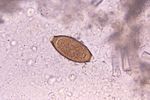Whipworm infection: Difference between revisions
No edit summary |
m (Bot: Removing from Primary care) |
||
| (28 intermediate revisions by 14 users not shown) | |||
| Line 1: | Line 1: | ||
{{ | __NOTOC__ | ||
{{About1|Trichuris trichiura}} | |||
{{infobox Disease | | |||
Name = Trichuriasis | | |||
Image = Trichuris egg.jpg | | |||
Caption = Trichuris egg | | |||
}} | |||
{{Whipworm infection}} | |||
{{CMG}}; {{AE}} {{CZ}}, {{AKI}}, {{USAMA}}, {{HK}} | |||
{{ | |||
{{SK}} Trichuriasis, Human whipworm infection, Trichocephalus, Trichuriose | |||
==[[Whipworm infection overview|Overview]]== | |||
==[[Whipworm infection historical perspective|Historical Perspective]]== | |||
==[[Whipworm infection classification|Classification]]== | |||
== | ==[[Whipworm infection pathophysiology|Pathophysiology]]== | ||
==[[Whipworm infection causes|Causes]]== | |||
== | |||
[[ | ==[[Whipworm infection differential diagnosis|Differentiating Whipworm Infection from other Diseases]]== | ||
==[[Whipworm infection epidemiology and demographics|Epidemiology and Demographics]]== | |||
== | ==[[Whipworm infection risk factors|Risk Factors]]== | ||
[[ | ==[[Whipworm infection natural history, complications and prognosis|Natural History, Complications and Prognosis]]== | ||
==Diagnosis== | |||
[[Whipworm infection history and symptoms|History and Symptoms]] | [[Whipworm infection physical examination|Physical Examination]] | [[Whipworm infection laboratory findings|Laboratory Findings]] | [[Whipworm infection electrocardiogram|Electrocardiogram]] | [[Whipworm infection chest x ray|Chest X Ray]] | [[Whipworm infection CT|CT]] | [[Whipworm infection MRI|MRI]] | [[Whipworm infection echocardiography or ultrasound|Echocardiography or Ultrasound]] | [[Whipworm infection other imaging findings|Other Imaging Findings]] |[[Whipworm infection other diagnostic studies|Other Diagnostic Studies]] | |||
==Treatment== | ==Treatment== | ||
[[Whipworm infection medical therapy|Medical Therapy]] | [[Whipworm infection surgery|Surgery]] | [[Whipworm infection primary prevention|Primary Prevention]] | [[Whipworm infection secondary prevention|Secondary Prevention]] | [[Whipworm infection cost-effectiveness of therapy|Cost-Effectiveness of Therapy]] | [[Whipworm infection future or investigational therapies|Future or Investigational Therapies]] | |||
==== | ==Case Studies== | ||
[[Whipworm infection case study one|Case #1]] | |||
{{WH}} | |||
{{WS}} | |||
[[Category:Disease]] | |||
[[Category:Gastroenterology]] | |||
[[Category:Conditions diagnosed by stool test]] | |||
[[Category:Emergency mdicine]] | |||
[[Category:Up-To-Date]] | |||
[[Category: | |||
[[Category:Infectious disease]] | [[Category:Infectious disease]] | ||
[[Category: | [[Category:Pediatrics]] | ||
Latest revision as of 00:45, 30 July 2020
| Trichuriasis | |
 | |
|---|---|
| Trichuris egg |
|
Whipworm infection Microchapters |
|
Diagnosis |
|---|
|
Treatment |
|
Case Studies |
|
Whipworm infection On the Web |
|
American Roentgen Ray Society Images of Whipworm infection |
Editor-In-Chief: C. Michael Gibson, M.S., M.D. [1]; Associate Editor(s)-in-Chief: Cafer Zorkun, M.D., Ph.D. [2], Aravind Kuchkuntla, M.B.B.S[3], Usama Talib, BSc, MD [4], Syed Hassan A. Kazmi BSc, MD [5]
Synonyms and keywords: Trichuriasis, Human whipworm infection, Trichocephalus, Trichuriose
Overview
Historical Perspective
Classification
Pathophysiology
Causes
Differentiating Whipworm Infection from other Diseases
Epidemiology and Demographics
Risk Factors
Natural History, Complications and Prognosis
Diagnosis
History and Symptoms | Physical Examination | Laboratory Findings | Electrocardiogram | Chest X Ray | CT | MRI | Echocardiography or Ultrasound | Other Imaging Findings |Other Diagnostic Studies
Treatment
Medical Therapy | Surgery | Primary Prevention | Secondary Prevention | Cost-Effectiveness of Therapy | Future or Investigational Therapies